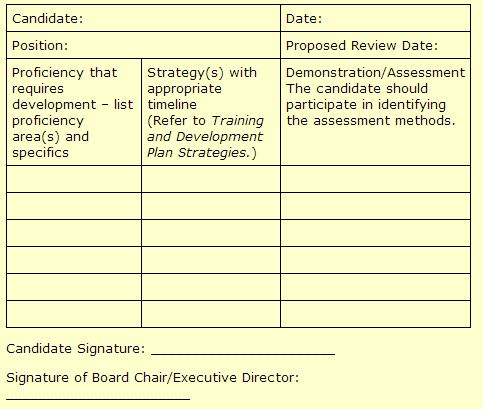 Plan for Leadership Succession
Plan for Leadership Succession
STEP EIGHT: Plan for Leadership Succession

Now that you have the background pieces in place it is time to start looking at leadership succession. This is a multi-step process and takes time to implement. Allow yourself the time you need to put these pieces into place.
First – Create a Proficiency Profile:
Start by determining whether any key staff will be retiring or leaving the organization within the next one to three years. Once you have identified any future vacancies, create a proficiency profile or an internal list of proficiencies for that position(s).
Proficiency Profile
A proficiency can be any knowledge, skill, or ability, demonstrated through behaviour that results in superior job performance. Some definitions include personal qualities, values, or traits as proficiencies. Examples of proficiencies include interpersonal effectiveness, teamwork, technical capability, and reliability. Proficiencies are not job descriptions. A job description looks at what and analyzes elements of the job. A proficiency model focuses on how.
For the position of Executive Director, you might consider the following types of proficiencies and how those proficiencies are used within your agency:
- Leadership – the proficiencies required to create vision, establish direction, develop strategy, and lead implementation (e.g., inspiring; motivating; modeling; coaching)
- Managerial – the ability to manage functions, plan and delegate work, and execute against a plan (e.g., planning; organizing; directing; controlling)
- Functional – the technical aspects of the job (e.g., computer literacy, literacy and basic skills vocabulary)
- Interpersonal – the ability to communicate and listen effectively
- Personal/Individual – self-awareness, integrity, commitment
Beware: It is common to think that a particular job, such as that of an Executive Director, requires a very high degree of proficiency. The current job holder may have developed to a very high level of proficiency over time – but this doesn’t make that level a requirement for a successor. If the bar is set too high, expectations may make it very difficult to fill the position. Too many proficiencies can increase the number of expectations to an unreasonable level.
Second – Conduct a Proficiency Gap Analysis:
Are there any current staff members who have the skills to step into that role now? Do they want to prepare to step into that role? If there are not any staff who are ready to step into that role, determine if there are any staff who are interested in developing the skills they need to move into that role.
In either case, conduct a Proficiency Gap Analysis. This assessment needs to be objective. Use the Proficiency Profile information that you gathered to develop a Proficiency Gap Analysis to assess a staff member’s readiness for the position. Conducting a proficiency gap analysis will help you to create the list of skills or proficiencies that a candidate already has and those that the candidate needs to develop for particular positions.
Proficiency Gap Analysis Template

Third – Create a Transition Plan:
If you believe that the interested staff member is a good candidate to fill the future vacancy, create a transition plan. This plan will help to prepare them to move into the role. This may be a detailed Candidate Training and Development Plan based on the gap analysis or a more informal transition plan. A transition plan will help you document the strategies and training required to bring a candidate to the proficiency level required for the position. This plan may include a mentoring or coaching component. The plan should include strategies to support the acquisition of the required proficiencies and the facilitation of the transfer of knowledge.
Sample Candidate Training and Development Plan





